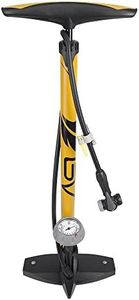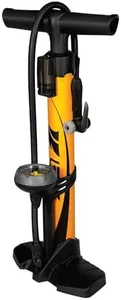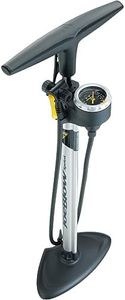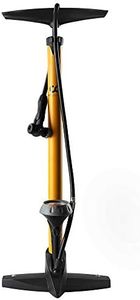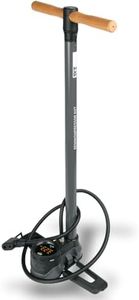We Use CookiesWe use cookies to enhance the security, performance,
functionality and for analytical and promotional activities. By continuing to browse this site you
are agreeing to our privacy policy
10 Best Bike Floor Pumps
From leading brands and best sellers available on the web.Buying Guide for the Best Bike Floor Pumps
Choosing a bike floor pump is all about ensuring your rides are smooth and your tires are always ready to go. The right pump can make inflating your tires quick, easy, and effective. Before you shop, it’s helpful to learn about the main features that make one pump different from another and how those differences align with the way you use or care for your bike. Think about your bike type, where you’ll keep or use your pump, and whether you'll need to inflate other items like sports balls or inflatable toys.Max Pressure (PSI/Bar)Max pressure tells you how much air (measured in pounds per square inch or bars) the pump can put into a tire. This matters because different bikes need different amounts of pressure: road bikes often require high PSI, while mountain bikes use much less. Pumps typically range from about 60 PSI (for basic or kids' bikes) to over 160 PSI (for performance bikes). If you have a road bike, choose a pump with a higher max PSI. If you’re an occasional commuter or have a mountain or cruiser bike, you can go for lower max PSI pumps which are easier to operate.
Pump Head Compatibility (Presta/Schrader Valve)Bike tires come with different types of valves—mostly Presta or Schrader. The pump head is the part that attaches to the tire valve. Some pumps fit only one type, but most modern pumps offer dual heads or a smart system to fit both. It's important because using the wrong head won't let you inflate the tire. Double-check which type your bike uses and look for a pump suited to that, or even better, one that handles both if you might inflate different bikes.
Gauge Placement and AccuracyThe gauge shows you how much pressure is in your tire as you pump. Accurate gauges help you avoid under- or over-inflating tires. Gauges are either at the base of the pump or near the handle. Base-mounted ones are easier to read for most people. Try to choose a pump with a gauge that is clearly marked and easy to see, especially if you need to stop at certain pressures for performance or safety.
Barrel Size and MaterialThe barrel is the tube that holds the air. Larger diameter barrels move more air and inflate tires faster but may be harder to reach very high pressures. Narrower barrels make it easier to hit high pressure but take longer to fill big tires. Barrels are made of plastic, steel, or aluminum. Metal barrels are more durable, while plastic ones are lighter but may not last as long. Choose based on whether you want quick inflating (large barrel) or high pressure (narrow barrel), and if you value durability over weight.
Stability and Base DesignStability determines how easily the pump stays upright as you use it. A wider or metal base provides more balance, making it easier to pump without the risk of tipping over. If you’ll use the pump on different surfaces (like grass or pavement) or want pumping to feel stable and secure, pay close attention to this detail.
Hose LengthA longer hose lets you reach your bike tire more easily, especially if the bike is on a stand, rack, or even inside a car. Short hoses can be annoying if you have to move your bike around or if you want more flexibility while pumping. Taller users or those with bigger bikes might prefer a pump with a longer hose for convenience.

